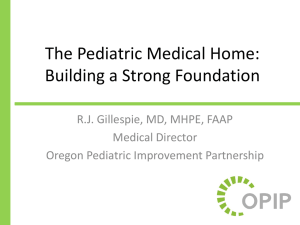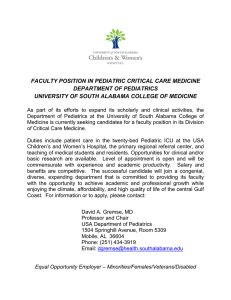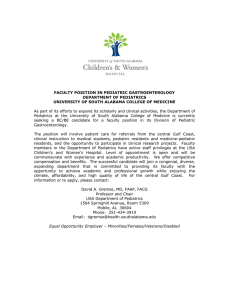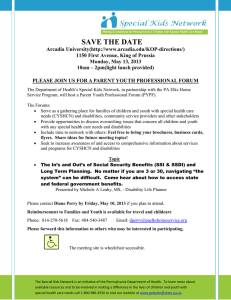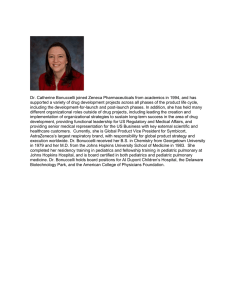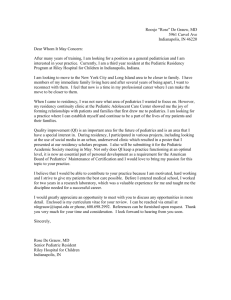Lost in Transition: Bridging the Gap Between Pediatric and Adult Medicine
advertisement
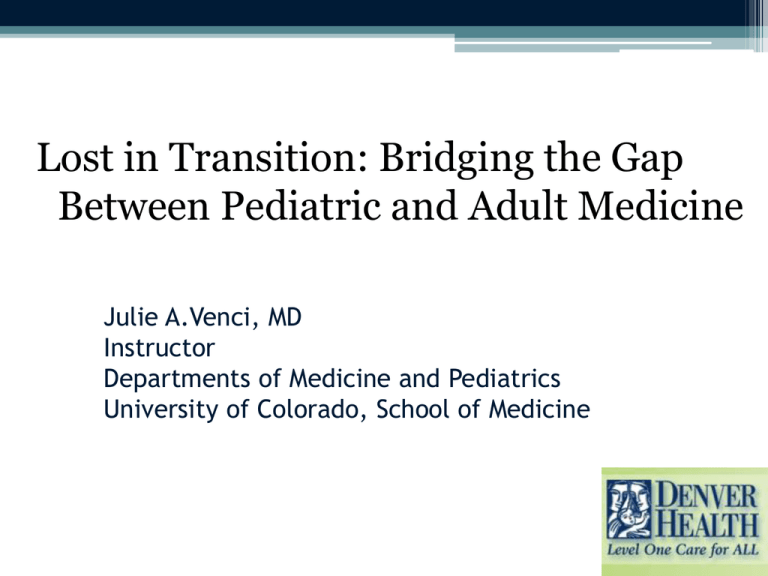
Lost in Transition: Bridging the Gap Between Pediatric and Adult Medicine Julie A.Venci, MD Instructor Departments of Medicine and Pediatrics University of Colorado, School of Medicine 8:30 AM: 24 y/o female - Establish Care 8:20am: 24 year-old female – Establish Care Objectives • Define transition and the patient centered medical home • Review how improved survival rates in childhood illnesses have changed how we practice medicine • Understand the challenges of transition from multiple perspectives • Present key elements to implementing a transition plan Transition Definition “The purposeful, planned and timely transition from child and family-centered pediatric health care to patient-centered adult-oriented health care.” Society for Adolescent Medicine, 1993 Patient Centered Medical Home Patient Centered Medical Home • Goals: ▫ Better quality ▫ Lower costs ▫ Improved care experience Children and Youth with Special Health Care Needs (CYSHCN) “Those who have or are at increased risk for a chronic physical, developmental, behavioral, or emotional condition and who also require health related services of a type or amount beyond that required by children generally.” Department of Health and Human Services, Health Resources and Services Administration Maternal and Child Bureau Children and Youth with Special Health Care Needs (CYSHCN) • Asthma • Spina bifida • ADHD • Down syndrome • Diabetes mellitus • HIV-AIDS • Sickle cell disease • Genetic and neuromuscular disorders • Cerebral Palsy • Cystic fibrosis • Chronic kidney disease • Inflammatory bowel disease • Congenital heart disease • Childhood cancer survivors • Solid-organ transplant recipients Why Transition is Important • Failure to recognize and plan transition may result in patients dropping out of care • Poor transition processes are recognized to have a significant negative effect on morbidity and mortality in young adults with chronic health needs No Longer Just a Childhood Illness • ~ 11.2 million children ( 15% of all US children) 0-17 years have special health care needs ▫ 500,000 CYSHCN turn 18 and enter adulthood in the US yearly • Survival rates have increased for children with chronic illnesses ▫ >90% survive beyond their 20th birthday Diagnosis Survival Info. Childhood Cancers • 46% of survivors are 20-40 y.o. • 18% of survivors are > 40 y.o. Cystic Fibrosis • Median survial 37 y.o. • 50% are > 18 y.o. Congenital Heart Disease • 85% reach adulthood • Over 1,000,000 living with CHD Down Syndrome 55-year life expectancy Hemophilia 60- year life expectancy Sickle Cell Disease 66- year life expectancy Spina Bifida > 80% reach adulthood Cystic Fibrosis Survival Consensus Statement on Health Care Transition for Young Adults With Special Health Care Needs • Goal of Transition: ▫ Maximize lifelong functioning and potential through the provision of high-quality, developmentally appropriate health care services that continue uninterrupted as the individual moves from adolescence to adulthood American Academy of Pediatrics American Academy of Family Physicians American College of Physicians American Society of Internal Medicine Healthy People 2020 • U.S. Dept. of HHS • 10-yr national goals to improve American health • Increase % of children (including CYSHCN): ▫ Receive care in family-centered, comprehensive, coordinated systems ▫ Have discussed transition with health care provider ▫ Have access to a medical home …So, how are we doing? National Survey of Children with Special Health Care Needs (NS-CSHCN): • 2009-10 telephone survey of CYSHCN < 18 y.o. • Topics covered: ▫ Health and functional status ▫ Health insurance status and adequacy of coverage ▫ Access to health care — including types of health care services needed and any unmet needs for care ▫ Preventive medical and dental care, and specialty services received ▫ Family-centeredness of child’s health care and care coordination ▫ Access to Community-Based Services ▫ Transition to Adulthood ▫ Impact of child’s health on family ▫ Demographics of child and family ▫ Education, family structure, primary language spoken in the home CSHCN age 12-17 years who receive services needed for transition to adult health care, work and independence Nationwide vs. Colorado 40 42.1 Outcome successfully achieved 60 57.9 Outcome not achieved What are the challenges? Patient Challenges • Many transitions at once: ▫ Graduate HS, move away, new job ▫ New relationships, new opinions about politics and religion ▫ Choices about alcohol, tobacco, drugs, sexual activity ▫ Focus on independence Family Challenges • Close ties with pediatric caregivers • Considered an adult at 18 y.o. privacy becomes an issue • Lack of confidence in: ▫ Young adult’s ability to adequately provide self-care ▫ Adult medical team “If it is a child, they will give them the pain medicine without questions, but when you turn adult, it’s a different thing. Like you’re not really in pain, you just want medications.” - Family member of a patient with Sickle Cell Disease Reiss J, Gibson R, Walker R., Health Care Transition: Youth, Family, and Provider Perspective. Pediatrics. 2005; 115;112. Pediatric Care Team Challenges • Tight bond with patient and family • Limited contact with adult providers and services • Lack of trust in adult healthcare system/providers • Lack of training on how or when to start transition Institutional & System Challenges • Aging out of treatment • Insurance coverage/funding changes with age: ▫ Limited options for personal health insurance ▫ Discontinued from parents’ health insurance ▫ Title V ends at 21 ▫ Change in eligibility requirements: Supplemental Security Income (SSI), Medicaid ▫ Services funded by Medicaid decrease after 21 • Poor reimbursement for transition services Adult Care Team Challenges Internists’ Perspectives • Study goal: Understand concerns of adult providers regarding transition for young adult patients with childhood-onset conditions • 2 stage mail survey from Aug. 2001-Nov. 2004: ▫ Stage 1: Providers stated concerns regarding accepting care of transitioning young adult patients ▫ Stage 2: Providers rated 45 items on a scale of how much the concern impacted ability to care for patient Internists’ Transition Concerns Patient’s maturity Patient’s psychosocial needs My medical Competency Systems issues Family involvement Transition coordination To review up to this point… • CYSHCN are living longer and need a smooth, coordinated transition for improved health outcomes • We are not doing a great job preparing patients for the transition to adult medicine • As internists, we have a number of concerns and limitations when it comes to taking care of CYSHCN What should a transition plan look like? • Expert opinion and consensus on practice-based implementation of transition for all youth beginning in early adolescence • Roadmap for transition and decision-making algorithms for all youth beginning at 12 y.o. Elements of Health Care Transition 1. Clinic Policies 2. Registry 3. Preparation 4. Planning 5. Transfer of care 6. Transition Completion 1. Clinic Policies • Pediatrics: ▫ When will the transition process begin? ▫ When is the transfer expected to happen? • Adult Medicine: ▫ What age will the clinic start seeing patient? ▫ Outline of what to expect 2.Registry • Pediatrics: ▫ Identify transition-age youth, especially CYSHCN ▫ Start by 12-14 y.o. • Adult Medicine: ▫ Identify young adults by level of complexity ▫ Monitor health care needs 3. Preparation – Pediatric Team • Prepare patients/family for success in adult care system & envision a future: ▫ ▫ ▫ Visits without parents Discuss illness, meds, troubleshooting Self-management skills • Assess Readiness: ▫ Transition Readiness Assessment Questionnaire (TRAQ): 2 domains: self management and self advocacy Identifies areas for more education 3. Preparation – Adult Team • Discuss how to use/access services in adult model of care • Continue to assess and address gaps in knowledge and skills ▫ TRAQ 4. Planning – Pediatric Team • Health Care Transition Action Plan: ▫ Checklist of goals/expectations prior to transfer • Portable Health Summary: ▫ Chronological account of patient’s past and current medical problems • Emergency Plan: ▫ Actions to be taken during urgent/emergent events 4. Planning – Adult Team • “Get acquainted” visit ▫ Up to one year before transfer • Continue to use and update: ▫ HCT Action Plan ▫ Portable medical summary ▫ Emergency care plan 4. Planning – Team Discussion • Insurance • Guardianship • Community resources 5. Transfer of Care – What age? • For most, between 18-21 y.o. • Other factors to consider: ▫ Is the patient medically stable? ▫ Is the illness terminal? ▫ Has transition readiness been assessed? ▫ What skills are still needed to make a successful transition? 5. Transfer of Care • Pediatrics: ▫ Direct communication with adult PCP and team ▫ Transition package: Transfer letter Health summary • Adult Medicine: ▫ Review history and talk to referring physician ▫ Introduce patient to clinic 6. Transition Completion • Pediatric PCP and team remains a resource for adult PCP/team What are the future needs? Education and Training • Pediatrics: ▫ How to plan and implement transition • Adult Medicine: ▫ Adolescent rotation ▫ Training: Insurance, guardianship, billing ▫ Disease/condition specific guidelines: Grand Rounds More in adult journals Institutional and Systems Support • Recognition that transition planning is a necessary and important aspect of quality health care • Funding for transition planning/resources ▫ Ancillary staff to serve as liaison and coordinator of transition: Removes burden from 1 provider Research and Advocacy • Identify best practices and cost-effectiveness for transition planning: ▫ Show that transition programs or planning improves health outcomes, patient quality of life and savings for institutions. • Adequate private and/or public health insurance to pay for transition services What we are doing at DH? • Westside Pediatrics- Denver Health: ▫ Center for Medicare and Medicaid Innovation (CMMI) grant ▫ Patient Registry: Identifying current CYSHCN in the clinic, 18-19 y.o. who need to be transitioned Goal is to start transition planning by 14 y.o. Resources • Family Voices: ▫ Training: Insurance, billing and coding, medical record keeping • Got Transition • Specialty Clinics: ▫ Adult Congenital Heart Disease Clinic ▫ Denver Adult Down Syndrome Clinic ▫ Special Care Clinic- Children’s Hospital Colorado “ Optimal health care is achieved when every person at every age receives health care that is medically and developmentally appropriate.” THANK YOU! A Consensus Statement on Health Care Transitions for Young Adults With Special Health Care Needs. Pediatrics 2002; 110;1304 Thank You! • Tricia Mestas, RN, Westside Pediatrics- Denver Health • Cynthia Peacock, MD, Baylor • Laura Pickler, MD, Childrens Hospital Colorado • Susan Cassell, Family Voices Colorado. • Holly Batal, MD, Denver Health
